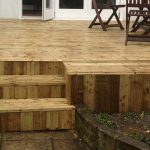
The battle between wood and composite decking materials has been going on for decades with mixed results. While wood decks were clearly winning the bids until some ten years ago, the composite decking materials improved immensely in terms of structure, durability and safety. Nowadays, the choice between both comes down to your own budget and personal preferences.
However, let’s examine the details between both wood and composite deckings and ultimately give you an overview on which one to choose for your new porch or terrace.
Here Fantastic Gardeners will teach you:
- The differences and similarities between wood and composite deck platforms.
- The cost factor and maintenance efforts put into both types of decking.
- What’s next after you make your choice
Table of Contents
What is wood decking?
Wood decking made from natural and high-quality materials can be considered an investment. In that case, how long does a cedar deck last? It ranges from 20 to 40 years depending on how well you maintain it. This principle applies to other types of wood as well. Maintenance is mandatory if you want your wood deck to last.
Expenses
The budget you need for a woodwork deck project varies from softwood to hardwood. Choose the best softwood timber according to affordability, colour and installation method. No pre-drilling is necessary, neither any kind of budget-soaring hidden fastening installations.
Pine softwood decks cost between £120 to £140 pounds per square metre.
Cedar also happens to be softwood but it’s out of the cheap range of products. It ranges between 160 to 180 pounds per square metre. Make sure that the screws are made of stainless steel – otherwise other metals might react in an unpleasant way with the cedar and leave black spots.
Don’t expect any cheap options when it comes to hardwood decking. In the UK, Ipe is one of the most common decking materials, as it is durable, but there are other options, such as Elondo, Teak, Merbau, Belinga, Kebony, Iroko, Cumaru, Kurupay and Massaranduba. Most of those come from South America and South-East Asia with their own specific traits, colour and grain differences.
The British standard for wood and wood-based products durability (BS EN 350-1) consists of 5 classes:
- I – high durability
- II – durability
- III – moderate durability
- IV – low durability
- V – no durability
A hardwood decking should have class 1 – otherwise, it’s not worth the money and its maintenance costs will very soon outpass the initial investment.
With installation methods varying, the most popular one is using pre-drilled boards. One of the cheapest hardwood materials, pre-drilled and with basic design, will cost anywhere between £190 and £220 per square meter.
Maintenance
Wood decks of lower quality such as pine, can withstand climate changes more easily, unlike ipe and mahogany.
If the wood absorbs moisture quickly, then it will need to be sealed and stained. You can check if that’s the case by pouring a bit of water on top. If it remains on the surface, you can still postpone. Seal and stain the wood deck once every couple of years.
If the surface gets dirty in the middle of this time, then use a non-abrasive cleaner to polish the wood but nothing too harsh. You can always refer to a pro with enough experience to handle this troublesome task.
What is composite decking?
Aluminium composite decking panels which contain wooden starch and plastic (polypropylene). This material is well-established in practice as it looks stylish – it’s not easy to distinguish between composite and natural wood at first sight. This is due to the fact that the better part of the composite mixture (around 60 to 80%) is made of pieces of wood.
The rest of it is reserved for compounds, such as polyethylene, UV-stabilisers, pigments and so on. Therefore, this type of material is also known as WPC – wood polymer composite.
How long do composite decks last? Anywhere from 25 to 30 years without maintenance. If you prefer to save yourself the trouble of oiling your deck, then go with composite materials.
Expenses
The price of the decking heavily depends on the different manufacturer, as well as the material, shape and complexity. Anywhere between £180 and £240 – it will include the installation fee, too.
Different manufacturers in and about London include:
- EcoDek;
- Tilon;
- Xyltech;
- Exterpark Tech Composite Decking;
Maintenance
Nowadays, decking designers love the composite decks and apply it to form terraces, porches, alleys, children playgrounds, outdoor areas, quays and pools. Of course, the main disadvantage of the composite wood is that it’s not entirely a natural product. However, looking at the fact that you are surrounded by plastic – from the electric appliances to your toothbrush – you won’t be able to move to an environment where you’re living with natural materials ONLY.
Furthermore, thanks to the polymer compounds inside the boards, several qualities that are highly sought after come into play:
- Water and radiation resistance;
- Resistant to some biological threats (bacteria, insects, rodents), but not mould;
- Durable to mechanical pressure;
- Resistant to different cleaning chemicals;
- Temperature resistant (between -60 to +80 °C).
Another comfortable benefit is this material doesn’t require periodical grinding or painting of the surface. That in itself can be a downside, because you have no way of removing scratches. The composite boards can be both hollow or solid, with hollow being of lesser quality – holding moisture leads to warping and deconstruction of the material. Solid composite resembles natural wood the most.
Despite the above given qualities, contrary to some outdated advertising, composite decks are not entirely maintenance free. Mould and pollen are their natural enemies. In order to lower the damage, always pick cleaning detergents that are specifically made for composite materials – otherwise, the deck colour might fade. Opt for a professional that is certified to deal with hard-to-remove stains when the situation’s beyond hope.
Popular questions
Is composite decking slippery?
Not really. It depends on the texture of your deck. Most composite decks have special textures which make them slip resistant when wet. Wood decks on the other hand lack this feature and can get quite slippery especially if there’s a thin layer of mold growing on them.
Do composite decks get hot?
They can get really hot really fast when exposed to direct sunlight. Of course, darker colours attract more sunlight compared to lighter ones. If you plan on building a composite deck with no trees around, consider going with a lighter colour.
Need a professional to help with the decking?
Enter your postcode to view our rates and availability in your area.
For questions about the services we offer visit our main site or you can always call us at 020 3404 4881
***
So, there you have it. All the details on composite VS wood decking. Which one do you have? Would you have chosen the other one if you had the chance? Let us know in the comments below along with any tips and recommendations.




Hi name is Claudia and I have a big garden around my house that i maintain very well. I was planning to do some decking work in my garden. When i came across your article it gave me a clear idea in terms of what to use its advantages and disadvantages. Thanks for your article that work has started in my garden and will look perfect very soon. Keep up your good work.
Glad you liked it, Claudia!
Wood, always a better option.; More sustainability and durability with more life span.
Thanks for sharing this useful article.People may easily understand about wood plastic composite. These plastic composite gives natural wood look with elegance beauty.
Composite Decking is the better option. It eco friendly, its recyclable and relatively cheaper. It comes with varieties of designs as well in comparison to wood decking.
Thanks for the input, Paul!
It’s a good stuff about composite decking.
Good Decking! I like it!
hello, I treated each deck plank prior to painting them with four coats of grey decking paint before they were fitted to the frame and it looked great – sadly 3 months later there are brown marks all along the decking which I thought was dirt from rain (we haven’t used it much to get it dirty as it’s winter) but when I tried to clean it off with patio cleaner it’s not touched it, also tried a spurt from the jet washer and all that did was start to strip the paint off but the marks are still there and it looks awful. The staining seems to be coming though the paint from the wood below but it can’t be mould as it’s too new, any idea what it is & how to treat it please? I don’t want to re-paint until I know what’s causing it otherwise it’s just covering up the problem. Thank you.
We installed composite decking but first sign of rain and there is water stain Mark’s all over it.Could you tell me why this is?.
A lot of people are switching out their old wood decking for composite decking these days because it’s easier to maintain.
This blog which is about Wood Vs Composite Decking – Which Works Better is fabulous. I found your blog content incredible and I loved post content so much. I will share this post with my friends so they can also able to know more about decking. Keep sharing and well done.
Such a great blog. Through this people can easily estimate between the wood decking and the composite decking. I am impressed to see such details on both regarding cost and maintenance. It was good to read such informative content.
Awesome articles, thank you for taking the time to share your thoughts and insights!
All the information are awesome. Im happy I visited your site.
Wood decks were clearly winning the bids until some ten years ago, but the composite decking materials improved immensely in terms of structure, durability and safety. Nowadays, the choice between both comes down to your own budget and personal preferences. With so many great options available on the market today, it’s hard to go wrong with either type of decking material! Thanks for this blog!